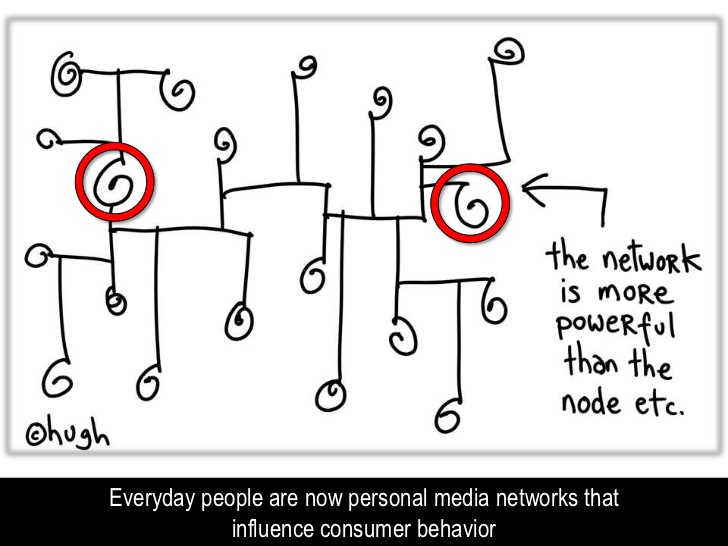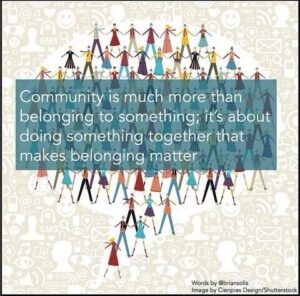About three weeks ago, I celebrated my first anniversary as Principal Analyst of Altimeter Group. And, it is with great pride that I mark the occasion with the release of my first official Altimeter report, “The Rise of Digital Influence.” Not a traditional market report, it was written as both a primer and a how-to guide for businesses to spark desirable effects and outcomes through social media influence.
We live in a time when social networks such as Facebook, Twitter, Google+, et al., not only connect us, they become part of our digital lifestyle. But it’s not just about how these networks help us connect and communicate with others. Whether we know it or not, our social activity now contributes to our stature within each network. New services such as Klout, PeerIndex among many others not only measure who you know, what you say, and what you do, they attempt to score or rank your ability to influence those to whom you’re connected. As a result, social network users are now starting to rethink how they connect and communicate to improve their stature within each network. And at the same time, brands are taking notice as these services also help organizations identify individuals who are both connected and relevant to help expand reach into new media and markets.
The potential for social influence is enormous on both sides of the equation. Services that rank and identify “influence” open the door to new opportunities for businesses to cultivate mutually beneficial relationships with digital tastemakers and authorities. Brands extend their reach into new networks and consumers earn recognition and reward for their online status. These new paradigms also present a number of unforeseen challenges as businesses and digital consumers alike come to grips with what influence is and isn’t.
The Rise of Digital Influence takes a deep dive into digital influence. It explores the emerging landscape for digital influence to provide businesses with a lens into how it’s earned and spent in social networks. Additionally, the report lays out an Influence Framework and an Influence Action Plan to identify connected consumers and to define and measure digital influence initiatives using an included step-by-step process. Through examples and a review of the digital influence tools available, businesses will posses a stronger grasp of how to develop effective engagement strategies and supporting processes.
Stephanie Agresta, EVP, Managing Director of Social Media, Weber Shandwick leads one of the newly created roles emerging to help businesses better understand the world of digital influence, “Influence is much more than a score. This is about reaching people not just because they’re connected, but because they serve a role within their online community. It’s up to brand managers, marketers and communications professionals to use influence tools to learn more about the social landscapes and the people who affect their markets. As the findings here point out, brands cannot think episodically about influence or influencers. This is not a campaign based discipline. While tools are helpful, the practice of IRM (Influencer Relationship Management) is about on-going engagement and community building. Today, that can happen at scale.”
The Rise of Digital Influence includes qualitative reviews of 14 influence vendors and also insights from domain experts including…
– David Armano, Executive Vice President, Global Innovation & Integration, Edelman Digital,
– Dr. Bernardo A. Huberman, Director, Social Computing Lab, Hewlett-Packard Laboratories
– Molly O’Donnell, Director of Influencer Marketing for Windows Phone, Microsoft
– danah boyd, Senior Researcher, Microsoft Research; Research Assistant Professor, NYU
Not only does it help you explore the emerging landscape for digital influence, it finally explains how it’s earned and spent in social networks. More importantly, the report introduces an Influence Framework and an Influence Action Plan to identify connected consumers and to define and measure strategic digital influence initiatives using an included step-by-step process.
Download the report…
The Rise of Digital Influence (Download from Slideshare)
Connect with me: Twitter | LinkedIn | Facebook | Google+ |
Photo Credit: Shutterstock







Happy anniversary! Excellent post, Brian. I’ll certainly chew on this for a while.
Love the “United Breaks Guitars” example ~ Have used many times. As for digital influence…You are my Greatest Influence! What interests me is how do you ‘explain’ that. How do we measure the ‘value’ of that. The ROI conversation is always about the $$ but I’m more interested in the stuff you can’t measure; positive sentiment, word of mouth…the psychology/sociology of it is what fascinates me. 🙂 (and happy anniversary – love what you do!)
There are many ways to “measure”. In broad strokes, start tracking the volume and valence of the conversations, and correlating/regressing that onto other business outcomes.
As the SEO guy, I was always the afterthought and the option no one understood. Now my department really is the heart of our company. Without SEO, no one will find your website or your business besides by word of mouth. Its amazing how in just a few years, the entire marketing and influence game can change.
Great post Brian. Hope to catch up with you soon.
Wow, 1st anniversary as Principal Analyst at Altimeter! Congratulations and this is a great post! Thank you.
This seems to be one of the most informative sources of information about digital media and business. My question is off track, but I’m doing a little research for my 16-year-old, who is considering college majors in the state of California. Were he wanting to specialize in ecommerce for b2c and b2b, and/or new media and business, what advice would you give him? He is a sponsored skateboarder with thousands of followers, an excellent student, and more than a little disheartened at the top-heavy calculus and statistics courses required for a traditional degree in business. Frankly, I’m with him on this one. So we began to rethink his approach today. While he compiles a paper for his personal health class, I’m doing a little research on his behalf with sources I respect.
For a kid who is going to be a junior next school year, what course of study or university degrees/colleges, interns, volunteer job tracks, etc. would you recommend? This is a tough one for me, an old school parent, to advise him on. So I seek the recommendations of those who are currently working in the field.
Bright analysis! I do agree on this.
Brian, First A big Thumps up for completing your one year …It really matters. I can feel that pride. Second, Your post seems great. I have been using social platforms for my company from some good time ..Have been trying to keep up with people at twitter facebook and linkedIn…Your post was something very valuable to me.
Je ne suis en aucun cas convaincu.
C’est juste “enrober” les choses et rien de “palpable”/concret.
Se lancer dans du bavardage, tout le monde sait le faire.
Où sont les idées/propositions/projets “concrètes” ?
C’est comme pour quelqu’un qui va aller chez un psy un espérant trouver une solution (des) à ses soucis/problèmes; en réalité le psy va juste l’écouter sans rien pouvoir proposer pour améliorer son état.
Ce truc de “bavardage” est à la mode et spéciphique, notamment à ceux qui n’ont plus des capacités professionnelles pour faire face aux exigences d’un projet/travail pouvoir aboutir à la création d’un nouveau produit/service “utile” pour le client/l’humain!
Votre type de “altimeter” n’apporte pas grande chose de nouveau sur le marché : c’est que des paroles qui cachent du vent.
Brian, I appreciate the discussion of reach, resonance and relevance as underpinnings of influence. In general, I have suspected that one of the most difficult things to measure is the depth of a relationship. I suppose one way to attempt to find out depth is to attempt to influence. However, there would need to be many data points to gauge influence since relationships between people are complex, correct? – David Chevalier
It’s important to note that the report is actually a constructive “how
to” guide for businesses to learn how to use tools such as Klout and
PeerIndex to build productive relationships with connected individuals.
Its theme is not so much about what influence is or isn’t as much as it
is about why what they track is useful and how to make it useful to
your business. The report shows how to use each tool to build an
effective “influence” strategy…step by step.
This is very interesting. I will take a read. The influence factor of social media is very important. A How to guide for connecting with top influencers is a great gift. I started a Klout account with very little knowledge, but the small details made sense in a growing social world. Thanks for post
Very interesting report Brian and i have been trying to conceptualise the ripple diagram featured myself for quite some time but have never cracked it like you have achieved in this report (i’m assuming this was David’s brilliance). I still feel this debate needs to turn to understanding the actual power of online influence overall relative to offline influence for many categories, how much budget should go to each? Offline influencers, on average, do over index for online influence but many online influencers are not the best face to face (that’s why they spend so much damn time tweeting!). Some categories just don’t lend themselves as well to authentic online influence such as say dishwashing tablets. Don’t get me wrong i know i can probably search and find some reviews on these things but offline has the luxury of many external triggers and relevance moments to generate these conversations authentically, say someone is over for dinner and they are helping you pack the dishwasher, cue conversation about dishwashing tablets and why they choose x over y. A tweet about ‘hey i’m loving my clean dishes with brand x’ just doesn’t seem quite the same. It is really important to understand online better as it’s here to stay as a channel but as Keller Fay report 90% of the brand-based conversations still happen in the real world and i hope this isn’t going to change anytime soon, i kinda like talking to people. Thanks again for the great report, good to create some discussion in this areas and not just accept influence scores blindly.
Thank you Sharyn. The ripple diagram is something I’ve been studying officially since 2008 and wrote about it first in Engage and then fully fleshed it out in The End of Business. I initially referred to it as Micro Disruption Theory only to learn, the more I studied, that it was actually tied to social capital. https://www.briansolis.com/2009/03/micro-disruption-theory-and-social/
I’ve also studied the effects of influence in the dynamic customer journey, which is also graphed out and presented in the new book. Here’s the image to show how activity can affect decisions at different stages of the purchase, included post-commerce… http://www.flickr.com/photos/briansolis/5909243790/
Hope that helps!
So this is a good start, and it’s refreshing to see Altimeter move into the right direction after the Empire Avenue conversations.
I would add that there are missing components. How do you measure passion and authenticity for an issue, Brian? I still would pick a bone about “your definition of influence.” I would also add that the definition of influence really goes back to Gladwell and Watts. To me, without grounding a conversation about influence within that larger debate its hard to take anyone’s definition seriously.
Still, nitpicking is easy, and this comment is not to punish a good deed. Given who you all are, this is a strong healthy step in the right direction. Thanks for taking it.
You are such a nit picker. Wait compared to me you are easy peasy.
My question is with 98% of human communication taking place outside of social media what does this 2% do you us? I mean email, SMS text, word of mouth, telephone, one way communication like watching TV, all blow away Social for volume of communication. So do you forget the 98%?
My view is Peer Index and Klout are tools but I don’t view them as much value in the scheme of things since they measure so little…which is really mostly twitter. And with only 14mil US twitter users each day (active users) and 27 to 40mil active facebook users (meaning those that do more than read) all facts btw based on daily tweet volume and facebook actions volume….we are blowing off the 8 in 9 consumers who aren’t using the networks today.
We don’t measure it. Multibrain.net does! ahaha how nice to have someone do it for you.
Brian,
Good primer. The largest takeaway from the report is that this “movement” towards leveraging digital influence is still in its nascent stages. While you’ve included four case studies, the results of each of the initiatives are still inconclusive, which means experimentation is still the task of the day.
There are plenty of shortcomings currently, but this will be an increasingly important area of focus over the next decade. While you’ve thoroughly highlighted some of the emerging tools, I believe we are still a long way off from anything practically meaningful. Some of my thoughts here – I’d love to get your comments.
http://www.brianvellmure.com/2011/11/02/in-search-of-a-meaningful-measure-of-influence/#.T3nrob9WqOE
Brian, good report but I am wondering whether digital influence (or at least digital influencers) is actually that important. Could it be that the people that represent consumers rather than those who influence consumers are the ones we should focus on? I got the impression from a number of the comments (Geoff Livingstone and Brad Grier) that others are also thinking that things (which I define as context and behaviours) are perhaps more important in creating influence that simply identifying influencers. Have spun my thoughts out a bit here http://richardstacy.com/2012/05/15/are-digital-influencers-actually-that-important/
The rise of Digital Influence is still very relevant 3 years after it’s initial publication – but I’d love to see an update that reflects what has happened, and what hasn’t. The democratisation/commoditisation of the power of marketing analytics and targeting has probably exceeded our initial expectations (Facebook ad targeting for example is fast, easy and affordable) whereas the broader social impacts expected from social enterprise seem to be taking longer to eventuate, or have lost momentum
Hello Dallas, it has indeed been some time. The core of the report is still solid. The framework is still solid. What has changed is that the tools are stronger than ever.
Look at insightpool, Augure, Little Bird, Tracker, eCairn….
Thanks Brian – I’d heard of Little bird but the others are new to me – I’ll check them out. BTW – Disqus seems broken on this page – I can’t see your response or reply directly – I had to do it via the Disqus popout.